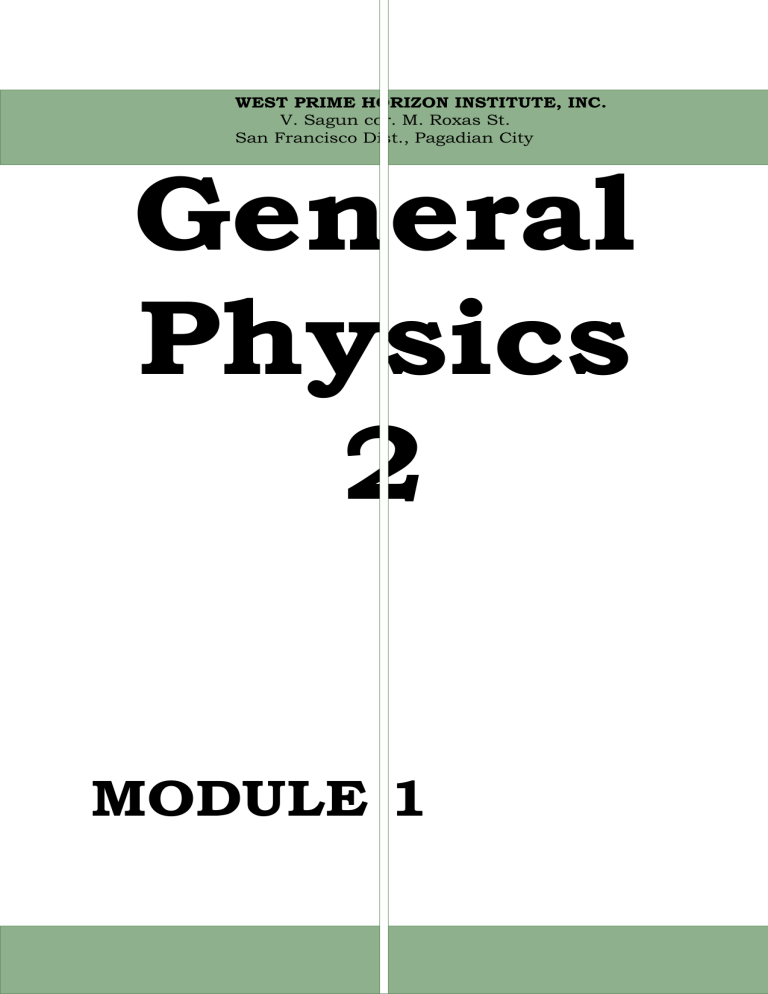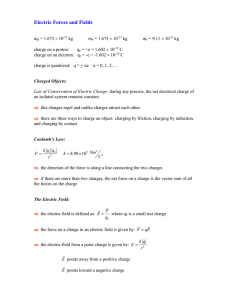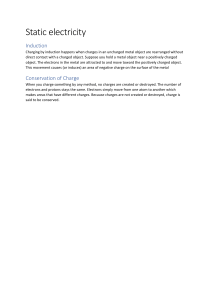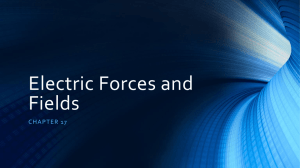
WEST PRIME HORIZON INSTITUTE, INC. V. Sagun cor. M. Roxas St. San Francisco Dist., Pagadian City General Physics 2 MODULE 1 PREFACE This module, was designed to explore the different phases of science specifically Physics. This was crafted in order to develop a culture of science among the students so that they will be honed as scientifically, technologically, and environmentally literate and productive members of society. It is our desire that through this module, we will be the instruments in the development of students even in this time of pandemic. Throughout this module they will learn the basic concepts of physics; this will test your ability on analyzing concepts without the actual discussion of topics. Table of Contents Contents Cover page Preface Lesson 1: Electric charge Page Number 1 2 3 Electric charge Learning objectives: At the end of the lesson, the students will be able to: a. explain the three processes of charging; and b. observe the materials given if it is belonged to conductors or insulators. 2|Page What is electric charge? Electric charge is the physical property of matter that causes it to experience a force when placed in an electromagnetic field. There are two types of electric charge: positive and negative (commonly carried by protons and electrons respectively). Like charges repel each other and unlike charges attract each other. An object with an absence of net charge is referred to as neutral. Early knowledge of how charged substances interact is now called classical electrodynamics, and is still accurate for problems that do not require consideration of quantum effects. Electric charge is a conserved property; the net charge of an isolated system, the amount of positive charge minus the amount of negative charge, cannot change. Electric charge is carried by subatomic particles. In ordinary matter, negative charge is carried by electrons, and positive charge is carried by the protons in the nuclei of atoms. If there are more electrons than protons in a piece of matter, it will have a negative charge, if there are fewer it will have a positive charge, and if there are equal numbers it will be neutral. Charge is quantized; it comes in integer multiples of individual small units called the elementary charge, e, about 1.602×10−19 coulombs, which is the smallest charge which can exist freely (particles called quarks have smaller charges, multiples of 1/3e, but they are only found in combination, and always combine to form particles with integer charge). The proton has a charge of +e, and the electron has a charge of −e. Electric charges produce electric fields. A moving charge also produces a magnetic field. The interaction of electric charges with an electromagnetic field (combination of electric and magnetic fields) is the source of the electromagnetic (or Lorentz) force, which is one of the four fundamental forces in physics. The study of photon-mediated interactions among charged particles is called quantum electrodynamics. Table 1.1 Properties of Proton, Neutron, and Electron Sub-atomic particle Location Mass Charge proton Inside nucleus 1.673 x 10-27 kg 1.602 x 10-19 C neutron Inside nucleus 1.675 x 10-27 kg 0 electron Around nucleus 9.109 x 10-31 kg -1.602 x 10-19 C The SI derived unit of electric charge is the coulomb (C) named after French physicist Charles-Augustin de Coulomb. In electrical engineering, it is also common to use the ampere hour (Ah); in physics and chemistry, it is common to use the elementary charge (e as a unit). Chemistry also uses the Faraday constant as the charge on a mole of electrons. The lowercase symbol q often denotes charge. An electric field (sometimes E-field is the physical field that surrounds each electric charge and exerts force on all other charges in the field, either attracting or repelling them. Electric fields originate from electric charges, or from timevarying magnetic fields. Electric fields and magnetic fields are both manifestations of the electromagnetic force, one of the four fundamental forces (or interactions) of nature. Electric fields are important in many areas of physics, and are exploited practically in electrical technology. In atomic physics and chemistry, for instance, the electric field is used to model the attractive force holding the atomic 3|Page nucleus and electrons together in atoms. It also models the forces in chemical bonding between atoms that result in molecules. The electric field is defined mathematically as a vector field that associates to each point in space the (electrostatic or Coulomb) force per unit of charge exerted on an infinitesimal positive test charge at rest at that point. The derived SI units for the electric field are volts per meter (V/m), exactly equivalent to Newton’s per coulomb (N/C). Electrostatic induction, also known as "electrostatic influence" or simply "influence" in Europe and Latin America, is a redistribution of electric charge in an object, caused by the influence of nearby charges. In the presence of a charged body, an insulated conductor develops a positive charge on one end and a negative charge on the other end. Due to induction, the electrostatic potential (voltage) is constant at any point throughout a conductor. Electrostatic Induction is also responsible for the attraction of light nonconductive objects, such as balloons, paper or Styrofoam scraps, to static electric charges. Electrostatic induction laws apply in dynamic situations as far as the quasistatic approximation is valid. Electrostatic induction should not be confused with Electromagnetic induction. A normal uncharged piece of matter has equal numbers of positive and negative electric charges in each part of it, located close together, so no part of it has a net electric charge. The positive charges are the atoms' nuclei which are bound into the structure of matter and are not free to move. The negative charges are the atoms' electrons. In electrically conductive objects such as metals, some of the electrons are able to move freely about in the object. When a charged object is brought near an uncharged, electrically conducting object, such as a piece of metal, the force of the nearby charge due to Coulomb's law causes a separation of these internal charges. For example, if a positive charge is brought near the, the electrons in the metal will be attracted toward it and move to the side of the object facing it. When the electrons move out of an area, they leave an unbalanced positive charge due to the nuclei. This results in a region of negative charge on the object nearest to the external charge, and a region of positive charge on the part away from it. These are called induced charges. If the external charge is negative, the polarity of the charged regions will be reversed. Since this process is just a redistribution of the charges that were already in the object, it doesn't change the total charge on the object; it still has no net charge. This induction effect is reversible; if the nearby charge is removed, the attraction between the positive and negative internal charges causes them to intermingle again. The sign of the charge left on the electroscope after grounding is always opposite in sign to the external inducing charge. The two rules of induction are: If the object is not grounded, the nearby charge will induce equal and opposite charges in the object. If any part of the object is momentarily grounded while the inducing charge is near, a charge opposite in polarity to the inducing charge will be attracted from ground into the object, and it will be left with a charge opposite to the inducing charge. Conductors Some materials let electricity pass through them easily. These materials are known as electrical conductors. 4|Page Many metals, such as copper, iron and steel, are good electrical conductors. That is why the parts of electrical objects that need to let electricity pass through are always made of metal. Metal is used in plugs to allow electricity to transfer from the wall socket, through the plug, and into a device such as a radio or TV. In a light bulb, the metal filament conducts electricity and causes the light bulb to light up. Insulators Some materials do not allow electricity to pass through them. These materials are known as electrical insulators. Plastic, wood, glass and rubber are good electrical insulators. That is why they are used to cover materials that carry electricity. The plastic covering that surrounds wires is an electrical insulator. It stops you from getting an electrical shock. Semiconductors are intermediate between conductors and insulators. These are not as conductive as metals, but they are more conductive than insulators such as rubber, plastic, and mica. The conductivity of a semiconductor in its pure form is very low. Atoms of different elements in every amount are added to pure semiconductors to improve their conductivity. Superconductors offer practically no resistance to the flow of charges below some critical temperatures. A current in a superconductor can keep flowing without any decay. Most superconductor only work at temperatures close to absolute zero. Processes of Charging The number of protons and electrons in an atom is equal; hence, an atom is neutral. However, it becomes an atom may gain or lose electrons. If the atom gains electron; it becomes negatively charged; if it loses electrons, it becomes positively 5|Page charged. There are three processes by which a neutral body may be charged. There are charging by friction, conduction, and induction. 1. Charging by Friction Charging by friction results when two different materials are rubbed together. The material that will either become positively charged or negatively charged depends on its electron affinity. Electron affinity is a measure of the attraction of an atom to an atom, or the tendency of an atom to become negatively charged. 2. Charging by Conduction Charging by conduction requires physical contact between a charging body and a neutral body. The sign of the charge acquired by the neutral body is the same with that of the charged body. A neutral body becomes positively charged when charged by a positively charged body. Likewise, it becomes negatively charged when charged by a negatively charged body. 3. Charging by induction A neutral body may be also charged without physical contact with a charged body. This process is called induction. In induction, the body to be charged is brought very near the charging body. The negative charges on a neutral body are attracted toward the charging body if the latter is positive. They are repelled from the charging body if it is negatively charged. This effect is known as polarization. The neutral body is then grounded either by touching it or using a wire. Name: _________________________________________Strand/Year/Block:_____________ Subject:________________________________________Score:_______________ 6|Page Activity 1 Electric Circuits – Conductors and Insulators Look at the materials below. Do you think connecting them to an electric circuit tester will make the light bulb turn on? Check “yes” or “no” then, test your prediction with the materials. Record your actual results. ITEM PREDICTION YES NO ACTUAL RESULTS (Conductor or Insulator?) 1. pipe cleanser 2. straw 3. nail 4. paper clip 5. marble 6. tongue depressor 7. chalk 8. pencil 9. washer 1. What type of materials were able to conduct electricity? _____________________________________________________________________________________ _____________________________________________________________________________________ 2. What type of materials were NOT able to conduct electricity? _____________________________________________________________________________________ _____________________________________________________________________________________ 3. When electricity moves easily through an object, we call it a(n) ___________________. 4. When electricity does not move easily through an object, we call it a(n)_____________. Name: _________________________________________Strand/Year/Block:_____________ Subject:________________________________________Score:_______________ 7|Page Activity 2 Explain the following processes of charging: (5points each) 1. Charging by friction 2. Charging by conduction 3. Charging by induction 8|Page





